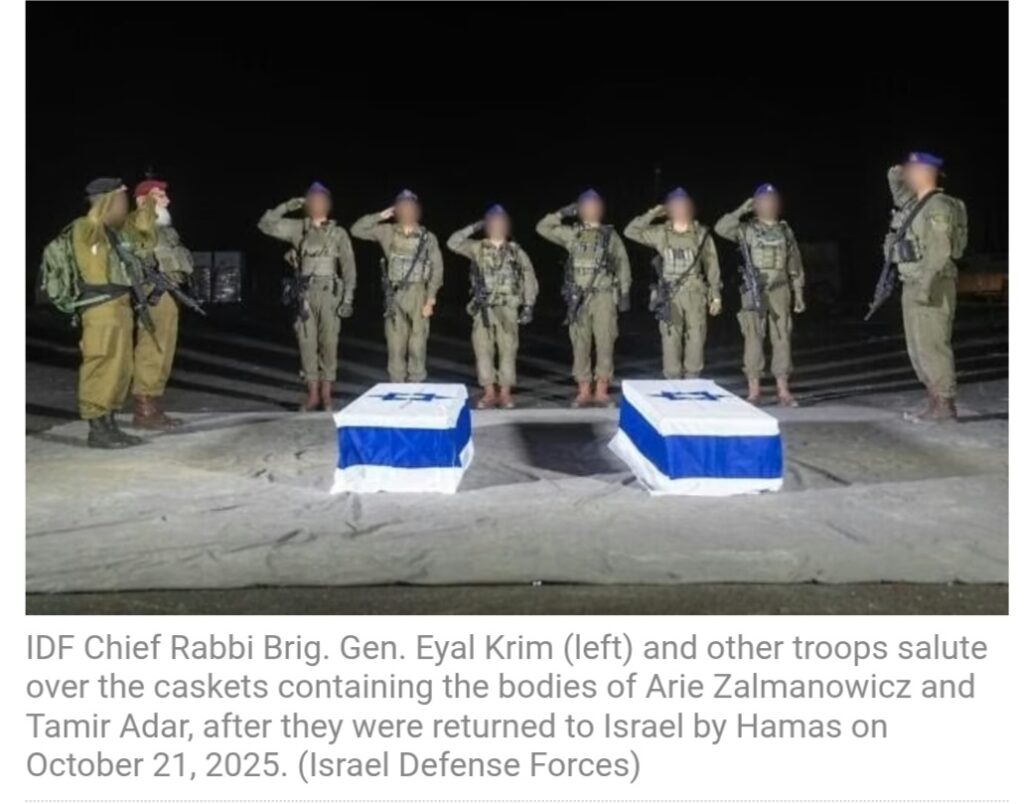
Israel has received the bodies of two unidentified Israeli hostages who had been held by Hamas in Gaza for two years.
According to the Prime Minister’s office, the coffins were handed over by Hamas to the Red Cross in Gaza yesterday, which transferred them to the Israeli military and Shin Bet security agents inside the enclave. From there, they will be transferred to Israel.
The bodies will be taken to the National Centre for Forensic Medicine in Tel Aviv.
The Israeli officials said efforts to return the country’s hostages will continue and will not cease until the last hostage is returned. Israel has estimated that the bodies of 28 hostages have been held in Gaza. Hamas has so far returned 15 bodies.
The Hamas terror group handed over two caskets to Israel via the Red Cross Tuesday night that were later confirmed to carry the remains of Kibbutz Nir Oz residents Arie “Zalman” Zalmanowicz, 85, and Tamir Adar, 38
The bodies, collected by the Red Cross in the southern Gaza Strip, were transferred to the Israel Defense Forces, after which troops inspected the caskets before draping them in Israeli flags and holding a short ceremony led by IDF Chief Rabbi Brig. Gen. Eyal Krim.
They were then taken out of Gaza to the Abu Kabir forensic institute in Tel Aviv for identification and to determine the causes of death, with military representatives notifying the families after their identities were confirmed several hours later.
Announcing earlier on Tuesday that it would return the bodies of two additional hostages, Hamas’s military wing said only that they were “retrieved today in the Strip” and did not identify them.
The transfer of the two bodies came a day after Hamas returned slain hostage Tal Haimi.
The repatriation of the remains of Zalmanowicz and Adar brought the number of bodies of deceased captives still held in the Strip down from 15 to 13. At the start of the ceasefire on October 10, the bodies of 28 deceased hostages were held inside the Gaza Strip.
In accordance with the ceasefire deal, Hamas released the last 20 living hostages last Monday, within 72 hours of Israel’s withdrawal to the Yellow Line. Hamas has also returned the remains of 15 slain hostages during the ceasefire.
The remaining deceased hostages include a soldier killed fighting in the 2014 Gaza war — the last remaining captive from before the Hamas onslaught of October 7, 2023.
Separately, the Red Cross said Tuesday that it had facilitated the transfer of 15 Palestinian bodies from Israel to Gaza under the ceasefire deal, taking the total handed over to 165.
“The International Committee of the Red Cross (ICRC) today facilitated the transfer of deceased Palestinians to authorities in Gaza…. Local health authorities in Gaza have confirmed the number of deceased received today is 15,” the Red Cross said in a statement.
Under the Gaza ceasefire deal, Israel returns the bodies of 15 Palestinians for the body of every hostage returned. Israel confirmed Tuesday that Hamas handed over the 13th body of a hostage — Haimi — the night before.
Zalmanowicz, 85, was kidnapped from his home in Nir Oz on October 7. While seeking shelter in his reinforced room, he managed to text one of his sons that terrorists had infiltrated the kibbutz. Footage later emerged of Arie being driven inside Gaza on the back of a motorcycle, bleeding and wounded.
Hamas, in November 2023, released a clip showing Zalmanowicz’s body and claiming that he had died, which Israeli authorities did not corroborate at the time. On December 1, 2023 – after the release of 105 hostages during a ceasefire – the IDF announced that Arie had been killed in captivity “based on findings that were collected, and intelligence.”
Authorities declared his date of death as November 17, 2023, with the IDF on Tuesday citing intelligence information that he was murdered in captivity that day. The military stressed that final conclusions would be made upon the completion of an analysis into the cause of death.
After he was declared dead in 2023, Zalmanowicz’s family sat shiva, the traditional Jewish week of mourning, but could not hold a funeral without his body. He is survived by his two sons, Boaz and Yoav, and five grandchildren. His wife, Ruth, died in 1997.
Hostage Farhan al-Qadi, who was rescued by IDF troops in August 2024, recounted that he was held in a Gaza hospital with Arie, who was diabetic, and was with him when died due to lack of treatment, malnutrition and neglect.
“He told me stories. He had a granddaughter he loved so much and two sons who live up north, and he talked about them every chance he got,” al-Qadi recalled in an interview a week after his rescue. The day he died, “he was saying goodbye to the kibbutz, goodbye to his friends, goodbye to his granddaughter… It broke me. I tried to talk to him, I was calling him ‘Arie, Arie,’ but nothing. He wasn’t hearing me. And then it was all over.”
Zalmanowicz was one of four young men from Haifa who helped found Kibbutz Nir Oz – alongside Amiram Cooper and Oded Lifshitz, who were both also kidnapped and slain in captivity, and Shlomo Margalit, who survived the attack. Cooper’s remains are still held in Gaza.
“He was a man of agriculture, manual labor, and blue work clothes. He was a farmer by blood who knew how to appreciate and value the land and weather, understanding their impact on our lives,” Nir Oz said in a statement eulogizing Zalmanowicz.
Adar, 38, the deputy security coordinator at Nir Oz, was killed battling terrorists in the kibbutz on the morning of October 7, and his body was abducted to Gaza by members of the Popular Front for the Liberation of Palestine terror group.
His fate was not known for several months, until his family was informed on January 5 that he had been killed in the attack and his body kidnapped to the Strip. The family sat shiva for Tamir but was also unable to hold a funeral.
On the morning of October 7, Tamir set out to support the kibbutz’s local security team when news of the invasion began to arrive. He told his wife and children to stay locked in their reinforced room.
Like other civil defense squad members who were killed while fighting Hamas-led terrorists on October 7, Adar was posthumously promoted to the rank of master sergeant in reserves.
A notice from the kibbutz that announced his death noted that he was a “family man, who loved nature and people. He was a devoted fan of Maccabi Tel Aviv and was always surrounded by friends.”
Meanwhile, two IDF soldiers were lightly injured after their tank was hit by an explosive device in the Khan Younis area of the southern Gaza Strip earlier on Tuesday, the military said.
The two wounded troops were taken to a hospital and their families were notified, the IDF added.
The incident took place at 12:30 p.m., during efforts by the forces to clear the area where they are stationed of potential threats.
According to an initial military probe, no terror operatives were detected in the area when the bomb was detonated. The IDF is investigating when the explosive device was planted in the area.
The IDF also struck several targets in the area that had “posed a threat to the troops operating in the area,” according to military officials.
The incidents came two days after the ceasefire was tested, when gunmen emerged from a tunnel deep within Israeli-held territory in southern Gaza’s Rafah and launched RPGs at troops, killing two soldiers, Maj. Yaniv Kula, 26, and Staff Sgt. Itay Yavetz, 21. Another three troops were wounded by sniper fire in the same area.
In response, the military carried out strikes against 20 targets in Gaza, which the Hamas-run civil defense agency said killed 45 people, before it said it was returning to implementing the agreement. The death toll could not be verified and did not differentiate between civilians and combatants.
While the Israeli military directly blamed Hamas for the attack on the troops in Rafah, the terror group denied responsibility, claiming “communication has been cut off” with operatives in Israeli-controlled areas.

